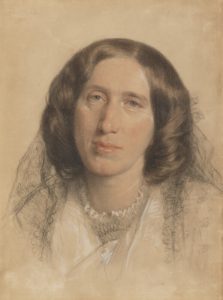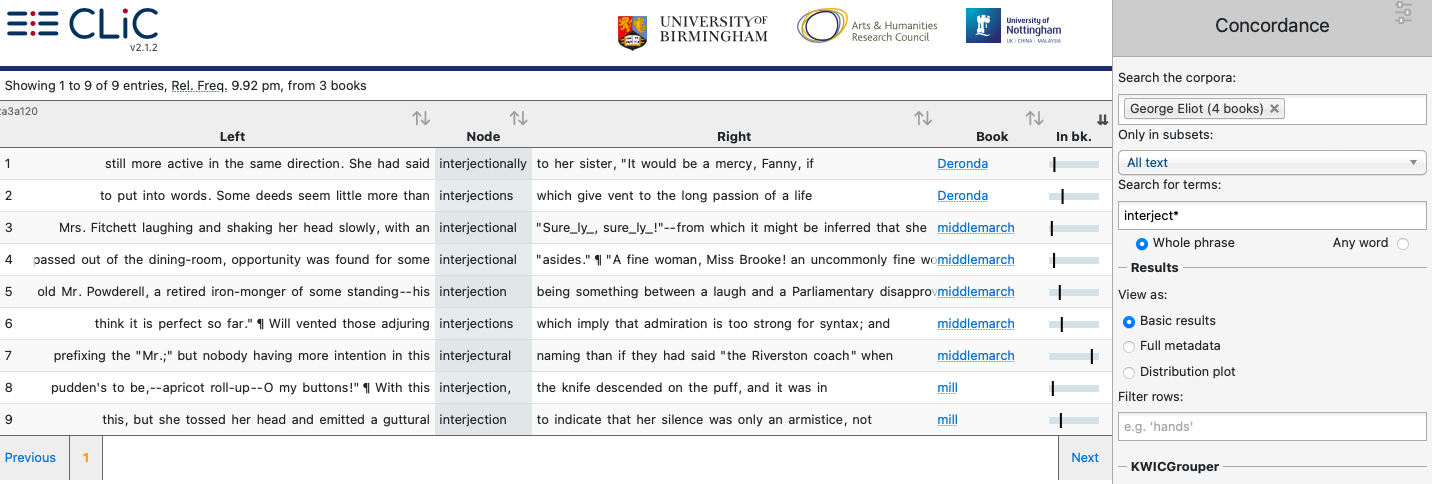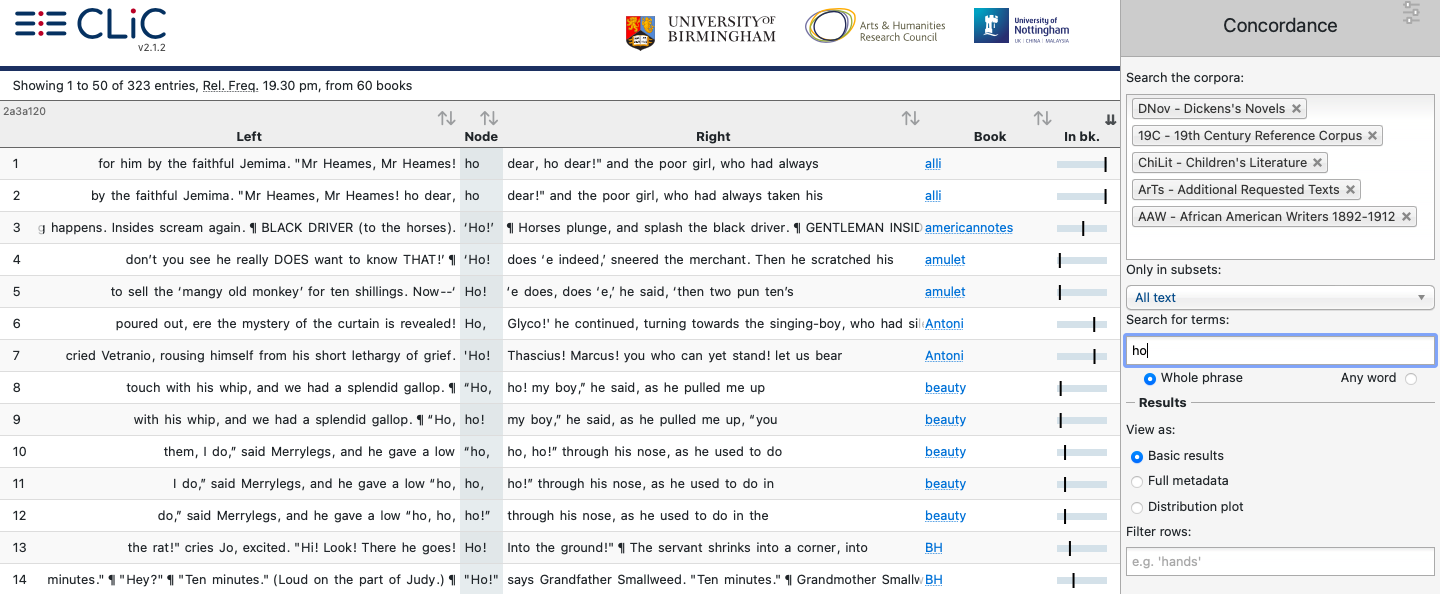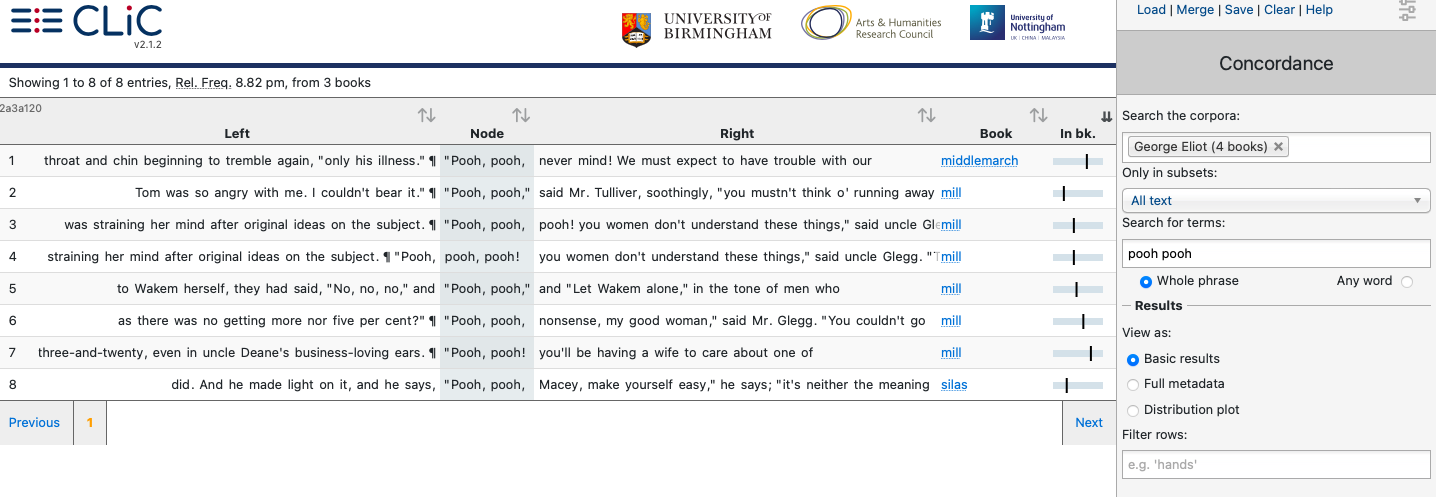Gregory Tate is a Senior Lecturer in Victorian Literature at the University of St Andrews. He is the co-organiser of the AHRC-funded ‘Victorian Literary Languages’ network, and he is writing a book titled The Grammar of Style in Victorian Fiction. In this post, Greg examines George Eliot’s use of, and commentaries on, interjections in her novels, and considers what George Eliot’s language can tell us about the complex and conflicting ways in which the Victorians understood these words.
I’m writing a monograph about the connections between literary style and prescriptive grammar in Victorian Britain, and I’ve found the CLiC web app (Mahlberg et al 2020) to be an invaluable tool with which to study the grammatical details of Victorian literary language. My focus in this post is specifically on interjections, a class of words that occupied an ambiguous place in nineteenth-century grammatical prescriptivism. In 1875, the educationalist Edwin A. Abbott defined the interjection, on the basis of the word’s Latin etymology, as ‘an utterance thrown in between words, to express emotion’, before dismissing it as ‘not a Part of Speech’ (xxiii). Earlier in the century, William Cobbett had been even more uncompromising in his exclusion of interjections from English grammar, insisting that they ‘are not words, because they have no definite meaning. They are mere sounds, and they have been mentioned by me, merely because other grammarians have considered them as being a Part of Speech’ (25).
But Lindley Murray, whose 1795 English Grammar arguably remained the most influential expression of grammatical prescriptivism throughout much of the nineteenth century, was less certain that interjections could be dismissed as ‘mere sounds’. In his view,
‘the interjection seems scarcely worthy of being considered as a part of artificial language or speech, being rather a branch of that natural language, which we possess in common with the brute creation, and by which we express the sudden emotions and passions that actuate our frame. But, as it is used in written as well as oral language, it may, in some measure, be deemed a part of speech. It is with us, a virtual sentence, in which the noun and verb are concealed under an imperfect or indigested word’ (43-4).
Murray’s assessment summarises a duality which literary writers, as well as grammarians, recognised in interjections: on the one hand, he identifies them as nonlexical and agrammatical, as unmediated expressions of bodily feeling. On the other hand, he acknowledges their widespread usage in written as well as spoken English, conceding that they have the capacity to convey semantic meaning, and even to assimilate and encompass other parts of speech. These two, seemingly opposing, views were to some extent reconciled in the evolutionary framework that shaped much Victorian writing about language: precisely because of their origins in involuntary physiological reflexes, interjections were identified as the evolutionary foundation of language, expressive of the essential elements of human psychology. In his 1852 article ‘The Philosophy of Style’ in the Westminster Review, Herbert Spencer argued that ‘extreme brevity is one of the characteristics of passionate language’, and that ‘the strongest effects are produced by interjections, which condense entire sentences into syllables’ (452 and 437).

As de facto editor of the Westminster Review in the early 1850s, George Eliot read and published Spencer’s essay, and her fictional practice agrees with his theory in recognising the interjection as a legitimate tool of literary style. George Eliot uses interjections frequently throughout her fiction, and their grammatical ambiguity is illustrative of two sides of her literary style. Her approach to grammar is sometimes prescriptivist: ungrammatical language is presented as evidence of characters’ intellectual or ethical failings or limitations. But the realism of her fiction also depends on a prose which to some extent celebrates ungrammaticality, and which aims to mimic and record the colloquial informality of spoken English. Interjections play a part in both aspects of George Eliot’s style, and the CLiC web app has aided my research in two particular ways: by helping me to examine the relation between her narrative voices and the speech of her characters, and by enabling me to compare her practice with that of other Victorian novelists.

There are four George Eliot novels in CLiC’s corpora – The Mill on the Floss, Silas Marner, Middlemarch, and Daniel Deronda – and a concordance search for the term ‘interject*’ (using CLiC’s *wildcard feature) locates examples of ‘interjection’, ‘interjections’, ‘interjectural’, ‘interjectional’, and ‘interjectionally’ in three of them. The relative frequency of these words in George Eliot’s novels is 9.92 per million. In comparison, their relative frequency in Charles Dickens’s novels is 2.35 per million, and across all of the texts in CLiC’s five corpora it is 2.57 per million. There are two possible explanations for the higher frequency in George Eliot’s fiction, I think: either she uses interjections more frequently than other Victorian novelists, or she is more interested in incorporating metalinguistics – the direct discussion and analysis of language – as part of her literary style.
A specific example from this search concisely shows how George Eliot’s metalinguistic commentary works. In chapter 18 of Middlemarch, there is a disagreement among the board of the Middlemarch infirmary about the appointment of a new chaplain, and a local worthy takes issue with the views expressed by the physician Dr Sprague: ‘“Ho, ho! Doctor,” said old Mr Powderell, a retired ironmonger of some standing – his interjection being something between a laugh and a Parliamentary disapproval’ (183). By presenting the monosyllable ‘ho’ as accessible to and requiring analysis, the narrator of Middlemarch illustrates the Victorian understanding of the interjection as a form of speech that, despite its seeming ungrammaticality, can articulate a complex of different emotions and meanings. And the particular interpretation offered by the narrator exemplifies the duality of Victorian interjections: Powderell’s ‘ho’ is poised between a laugh – a physiological expression of emotion – and ‘a Parliamentary disapproval’ – a culturally specific utterance, deliberately deployed to convey a particular argumentative and rhetorical response.
Using CLiC’s ‘subsets’ tab, I found that all of the examples of ‘interject*’ in George Eliot’s novels occur either in ‘non-quotes’ (i.e. the narrative voice rather than characters’ speech) or specifically, in this case, in a narratorial suspension inserted between a character’s words. And a concordance search for ‘ho’ reveals that this word appears less frequently in George Eliot’s novels than it does in Dickens’s fiction or across CLiC’s five corpora. This suggests two potentially interesting conclusions. It appears that George Eliot’s fiction is far from unusual in using interjections in characters’ dialogue: in fact, their use is widespread, and perhaps more frequent, across nineteenth-century fiction in general. However, George Eliot is unusual inasmuch as direct metalinguistic analysis of characters’ interjections is a distinct element of her style, which appears to be less prominent in the writing of other novelists.

Another characteristic of Mr Powderell’s ‘ho, ho!’ – its repetition – sheds further light on the place of interjections in Victorian theories of language and in literary style. George Eliot’s characters frequently repeat their interjections. For example, the interjection ‘pooh’ appears 24 times in the George Eliot novels on CLiC, and a search using the ‘clusters’ tab shows that 15 of these form part of phrases in which the word is used twice or, in one instance, three times. Across the five corpora as a whole, the ratio is not dissimilar: roughly half of the instances of ‘pooh’ on CLiC appear within repetitive phrases.

‘“Pooh, pooh, pooh! you women don’t understand these things,” said uncle Glegg’. – The Mill on the Floss (1860)
As the examples from The Mill on the Floss suggest, ‘pooh’ is often used in George Eliot’s fiction as an index of characters’ failure to listen to and sympathise with others: it is typically spoken by men who belittle the concerns of women. In this respect, the interjection appears as a crafted element of social and literary language: a conventional and deliberate sign of dismissal on the part of the speakers, and an aid to characterisation on the part of the novelist. But the repetition of words such as this was seen by some Victorians, conversely, as a demonstration of the physiological and unconscious origins of language. George Eliot’s partner George Henry Lewes writes in Problems of Life and Mind (1874-9) that ‘it is difficult under excitement to restrict oneself to a single utterance’: ‘we repeat phrases, the repetition being even more emphatic’. This happens, Lewes argues, because ‘in cases of unusual cerebral excitability the recurrent impulse of feeling’, equally psychological and physiological, ‘has an exaggerated energy’ (4:307). Repeated throughout George Eliot’s novels and Victorian fiction more widely, words such as ‘ho’ and ‘pooh’ exemplify the duality not just of interjections but of language in general: they are simultaneously ‘mere sounds’, which ‘express the sudden emotions and passions that actuate our frame’, and complex lexical signifiers that convey a range of literary, rhetorical, and social meanings.
References
- Abbot, E. A., (1875) How to Parse: An Attempt to Apply the Principles of Scholarship to English Grammar, Seeley, Jackson, and Halliday.
- Cobbett, W., (1819) A Grammar of the English Language, in a Series of Letters, Thomas Dolby.
- Eliot, G., (1994) Middlemarch, ed. by Rosemary Ashton, Penguin.
- Lewes, G. H., (1874-9) Problems of Life and Mind, 5 vols., Trübner.
- Mahlberg, M., Stockwell, P., Wiegand, V. and Lentin, J. (2020) CLiC: Corpus Linguistics in Context (https://clic.bham.ac.uk/).
- Murray, L., (1830) English Grammar, Adapted to the Different Classes of Learners, Longman, Hurst, Rees, Orme, Brown, and Green.
- Spencer, H., (1852) ‘The Philosophy of Style’, Westminster Review, 58, 435-459.
Please cite this post as follows: Tate, G. (2022) ‘George Eliot’s Interjections’ [Blog post]. CLiC Fiction Blog, University of Birmingham. Retrieved from [https://blog.bham.ac.uk/clic-dickens/2022/12/13/george-eliots-interjections/]

Join the discussion
0 people are already talking about this, why not let us know what you think?